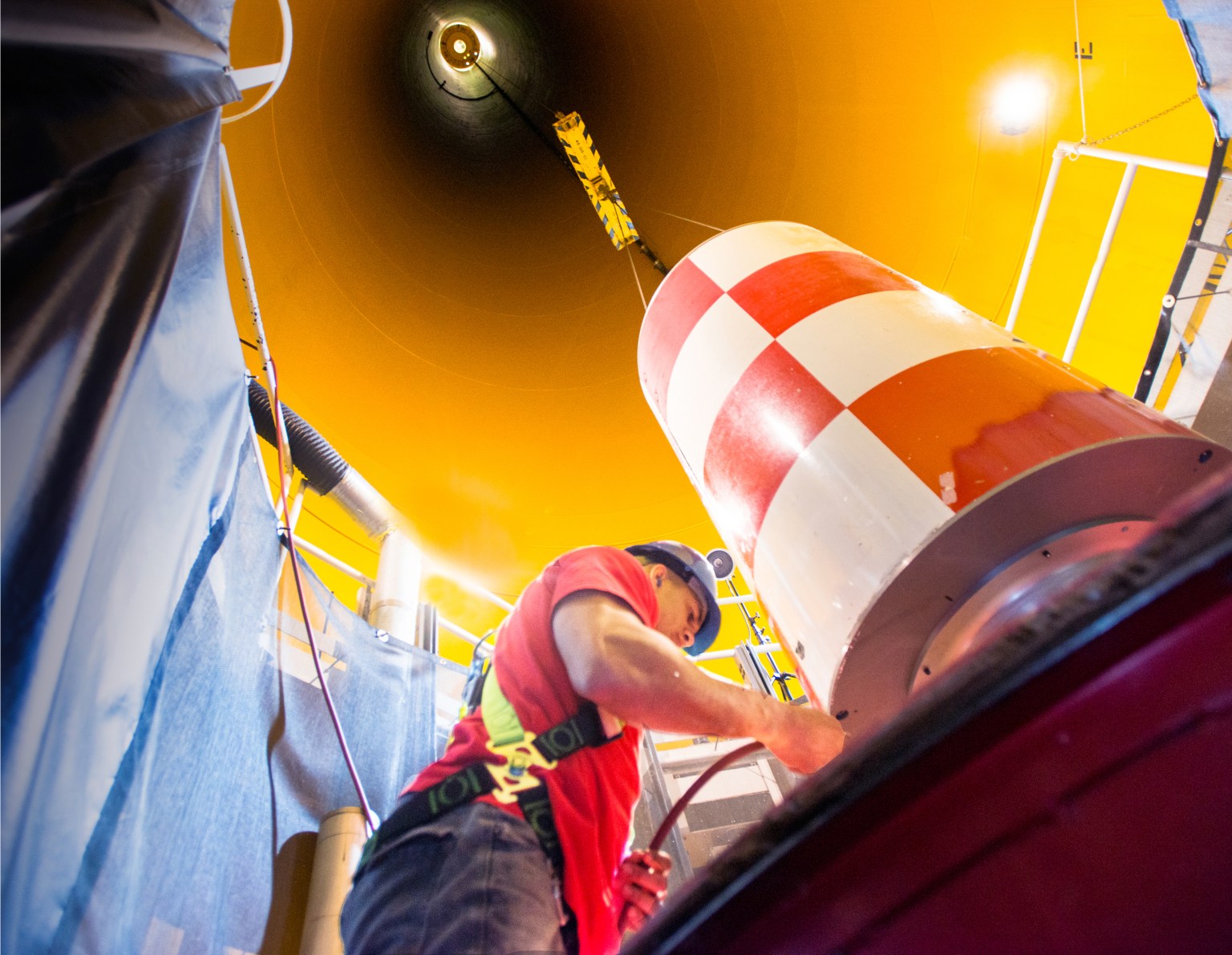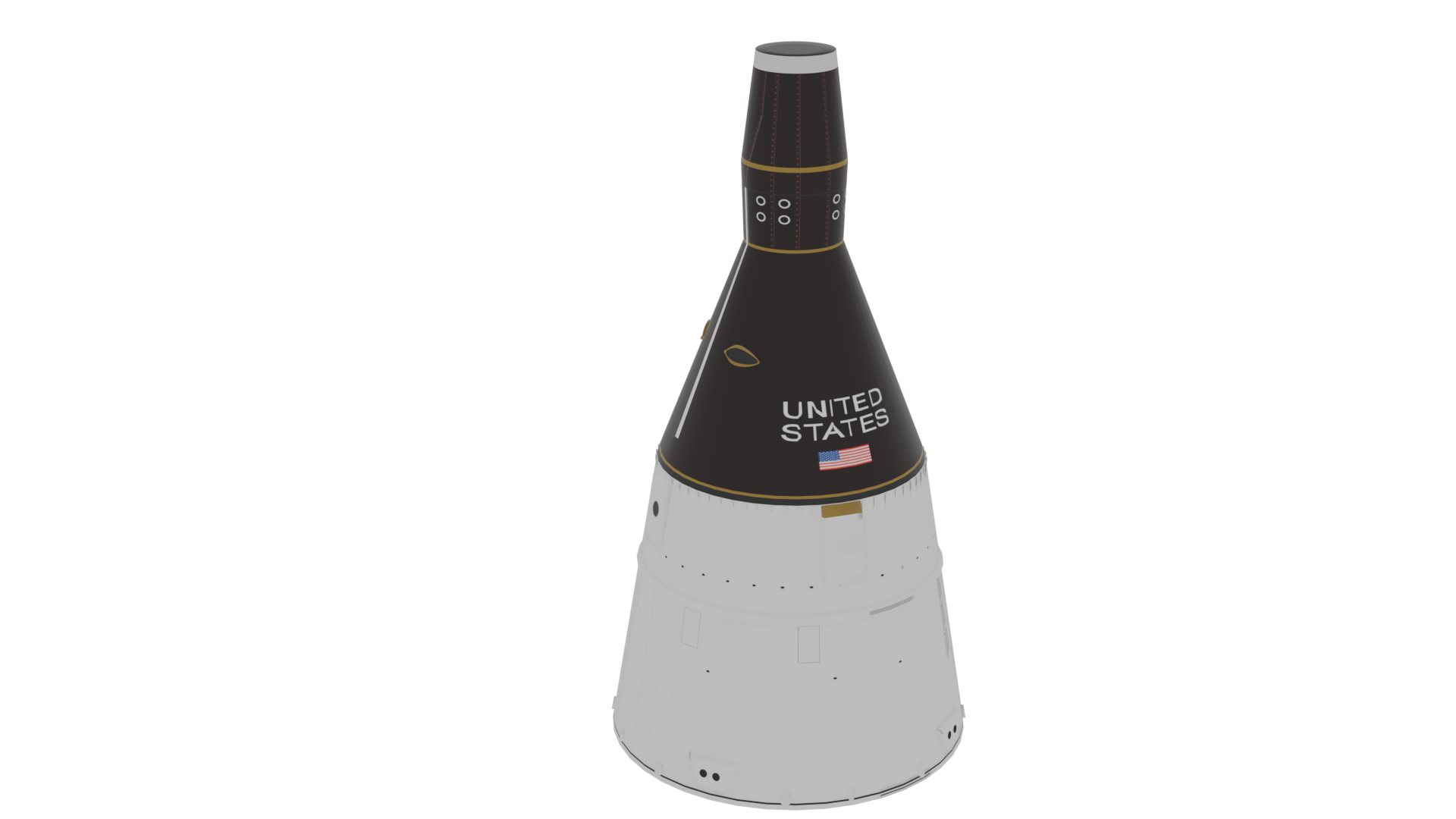Probe Calibration Laboratory (CE-12)
CE-12 is a 3.5-inch-diameter free jet facility that is primarily used to characterize the performance of various types of flow-sensing instrumentation such as flow angle, hot-wires, and total temperature probes. The facility has also been used for small-scale research projects.
The facility is supplied by 40-psig combustion air. Prior to entering the 29.2-inch-diameter (I.D.) plenum chamber, containing multiple flow straightening and turbulence reduction devices, the flow passes through a 1-micron filter, is throttled to the desired mass flow rate by 1.5-inch- and 6-inch-diameter parallel control valves, and can be heated by an immersion heater capable of raising the flow temperature to 200°F. The flow then passes through a 70:1 contraction ratio and exits through a 3.5-inch-diameter nozzle. A 125-psig service air line is also present in the facility; however, it is primarily used for the operation of facility control valves and instrumentation.
CE-12 is equipped with the standard NASA Glenn Probe Actuator and Control System (PACS). This control system interfaces with the facility data acquisition system to allow data to be obtained automatically at a predefined schedule of probe positions, angles, time intervals, etc. Various probe alignment and actuator systems are available for use, including a pitch-yaw table, which allows a probe tip to be positioned at the centerline of the free jet while varying the probe’s orientation.
| Operating Envelope | |
|---|---|
| Mach Number, M | 0.05 to 0.90 |
| Static Pressure, Ps | Barometric pressure |
| Total Temperature, TT | Ambient to 200°F |
Facility Data Acquisition and Instrumentation
CE-12 is equipped with the standard NASA Glenn COBRA (Collect, Observe, Broadcast, Record, and Analyze) data acquisition system and the Netscanner pressure measurement system for acquiring pressure data. All data collected with COBRA is sampled at 12.5 Hz. There are two 5-psid and two 15-psid pressure scanning modules available with 16 channels per module. The Netscanner and PACS systems are interfaced with the COBRA data acquisition system. CE-12 can accommodate 12 of each of the following thermocouple types: E, K, and T.
CE-12 System Instrumentation
| System | Number and Type |
|---|---|
| Netscanner | 32 Ports of ± 5 PSID 32 Ports of ± 15 PSID Barometric Reference |
| COBRA | 160 channels ± 10V |
| Thermocouples | 12 Type E 12 Type K 12 Type T |
| Other Information | Test cell wired with laser interlocks and power |
Advanced Nozzle Test Facility (CE-22)
CE-22 is used to test and develop advanced nozzle concepts. Testing examples include verification of computational fluid dynamics (CFD) and measurement of scaled nozzle performance. Customer models are installed in the test chamber, which is supplied by combustion air and altitude exhaust. The chamber separates to allow access to the model. Primary air enters the tank axially and passes through a bellmouth flow measuring section; secondary air enters through two ports in the top of the tank. The facility can provide primary combustion air at 40 psig and secondary air at 40, 125, or 450 psig. The 40-psig primary air and the secondary air can be heated up to 370°F and 250°F respectively. The test chamber can simulate altitude conditions from atmospheric up to 48,000 feet.
CE-22 Special Features
The facility’s six-component thrust stand has a 3,000-pound limit in the axial direction and 1,000-pound limits in the vertical and lateral directions. An ESCORT D data acquisition system is interfaced with an electronically scanning pressure (ESP) system to acquire and record steady-state data. Dynamic data is recorded with a Dewetron system at a maximum sampling rate of 200,000 per second. In addition to quantitative measurements, a rainbow Schlieren system and other flow visualization techniques are available for qualitative airflow analysis. A remotely operated camera system can record testing footage. The test facility and control room can support secure testing.
CE-22 Facility Capabilities
| Parameter | Operating Values |
|---|---|
| Inlet Air: Primary Flow | 40 pounds/second at 40 psig at 370oF |
| Inlet Air: Secondary Flow | 21 pounds/second at 40 psig, amb temp 2 pounds/second at 125 psig at 250oF 8 pounds/second at 450 psig at 250oF |
| Exhaust | atm to 20 to 26 inch hg vacuum |
| Model Size Limit | 8.75 inch inside diameter, 5 feet long |
CE-22 System Instrumentation
| System | Number and Type |
|---|---|
| ESP | 64 Ports of +/- 15 PSID 384 Ports of +/- 45 PSID 32 Ports of +/- 500 PSID Barometric Ref |
| Escort | 200 Channels of which 138 are available for the test article |
| Thermocouples | 96 Type K |
20×30 Inch Low-Speed Wind Tunnel (CW-13)
This test rig is self-contained and does not require central air services. The tunnel is used to study flow separation and its control over various model shapes, as well as to investigate 2-D shear layer flow fields. The tunnel draws air through a large rectangular bellmouth connected to an 80-inch-long test section. Downstream of the test section is a variable-speed, 10-hp motor that drives the air through the tunnel. The test section velocity can be varied from 0 to 15 m/s by controlling the speed of the tunnel drive motor.
CW-13 Special Features
The test section floor has a slot down the middle to allow insertion of probes. A sidewall and roof of the test section are made of Plexiglas to allow flow visualization consisting of a smoke wire used in conjunction with high-speed photography. A 20-inch-long spacer section upstream of the test section has bearings mounted in the walls to allow installation of airfoils.
In addition, CW-13 has a small jet facility that is now capable of producing heated jets at low Mach numbers with temperatures up to about 250oF. Without heating, this facility can provide supersonic jets up to a Mach number of about 1.5.
CW-13 Facility Capabilities
| Parameter | Operating Values |
|---|---|
| Test Section Size | 20 by 30 inch |
| Test Section Velocity | 0 to 15 m/s |
| Drive Motor | 10 hp, variable speed |
CW-13 System Instrumentation
| System | Number and Type |
|---|---|
| ESP | No |
| Escort | No |
| Laser | PIV (Particle Image Velocimetry) Rayleigh Scattering |
| Other Information | National Instruments LabVIEW, Hot Wire Anemometry, Automated Pressure Probe System, Setra pressure measurement instrumentation |
Free Jet Facility (CW-17)
This facility is used to conduct experiments to develop fundamental understanding of the jet mixing process and to increase jet mixing efficiency. The mixing process between a jet and surrounding airflow can be enhanced through use of aerodynamic excitation. CW-17 consists of a plenum chamber, excitation spool piece, and a nozzle. The 30-inch-diameter by 5-foot-long plenum is supplied with 125-psig combustion air. Each of several supply lines are controlled to automatically set and maintain the desired plenum pressure. Using adaptor pieces, various nozzles can be mounted off the plenum chamber. A swirl generator section can also be installed as part of the plenum.
CW-17 Special Features
A microphone array can be mounted at the nozzle exit to determine the output of the acoustic signal. Pitot tubes, hot wire probes, and microphones can be mounted on an XYZ table to survey the flow field downstream of the exit nozzle. A Labview-based data acquisition system, laser anemometry, and Schlieren systems are also available.
In addition, CW-17 has a small jet facility that is used primarily for Rayleigh-scattering based measurements. A filtration system is in place for providing clean, filtered co-flow needed for such measurements.
CW-17 Facility Capabilities
| Parameter | Operating Values |
|---|---|
| Supply Airflow and Pressure | Maximum of about 5 pounds/second airflow at 70 psig |
| Inlet Air Temperature | Primary air cold (although provision is there to heat the flow up to about 150oF with a 250 W heater (currently disabled)) |
| Altitude Exhaust | None (supply is there, but system is currently disabled, and will require major rework) |
CW-17 System Instrumentation
| System | Number and Type |
|---|---|
| ESP | None |
| Escort | No |
| Laser | Rayleigh Scattering |
| Other Information | National Instruments LabVIEW, Hot Wire Anemometry, Automated Pressure Probe, System Microphones |
Internal Fluid Mechanics Facility (W-1B)
Studies conducted in W-1B assist in the developing of CFD methods to aid in design and analysis of aircraft propulsion components and systems. The source of air in W-1B originates in the test cell entering the rig through a conical screen or it flows through a pressurized inlet tied to the 40-psig central system, providing higher Reynolds number test capability. Inlet air is drawn into an 8-foot-diameter plenum tank to condition the air entering the test section. A system can provide desired levels to turbulence, flow angularity, and boundary layer profile, as well as create swirlflow conditions. The tunnel flow is regulated from 0 to 4 pps and 4 to 25 pps by a 4″ valve and 12″ valve, respectively, and has a si channel blowing/bleeding system. Both valves are equipped with electronic controllers. The air is driven through the facility by the sub-atmospheric (altitude) exhaust.
W-1B Special Features
Detailed measurements of total and static pressure and three components of velocity are typically taken at nearly 2,000 locations from the inlet to the exit of the diffuser. Also, surface flow patterns are photographed by using a fluorescent-oil dye and an ultraviolet light for illumination. Data acquisition is handled through electronically scanned pressure (ESP) and probe actuator control (PAC) systems linked to an Escort processing system.
W-1B Facility Capabilities
| Parameter | Operating Values |
|---|---|
| Inlet Air Pressure | atm or 40 psig |
| Inlet Airflow | 20 pounds/second |
| Inlet Air Temperature | amb |
| Altitude Exhaust | 20 to 26 inch hg vac |
W-1B System Instrumentation
| System | Number and Type |
|---|---|
| ESP | 320 Ports of +/- 15 PSID 320 Ports of +/- 5 PSID 32 Ports of +/- 30 PSID Barometric Ref |
| Escort | 256 channels 250 available to the customer |
| Thermocouples | 36 Type E |
15×15 Centimeter Supersonic Wind Tunnel (W-6B)
The 225 cm2 Supersonic Wind Tunnel is a facility located in the Engine Research Building at NASA’s Glenn Research Center in Cleveland, Ohio. This continuous flow facility is used to study fundamental flow physics and serve as a test bed for instrumentation.
The facility is supplied by 40-psig combustion air. Prior to entering the plenum chamber, containing multiple flow straightening and turbulence reduction devices, the flow passes through a 1-micron filter and is throttled to the desired Reynolds number by an automated control valve. A facility heater can be used to maintain a constant temperature, slightly above ambient (typically about 100°F). From the plenum chamber, the flow then passes through an ASME bellmouth and interchangeable fixed-geometry converging-diverging nozzle block leading into the test section. Two nozzle/test section geometries, axisymmetric (17-cm-diameter) and square (15 by 15 cm), are available. The nozzle blocks currently available allow for operation up to Mach 3, but the facility is capable of supporting operation up to Mach 4. The tunnel can also operate at subsonic flows from Mach 0.25 to 0.85. A 125-psig service air supply line is also available for use in the facility.
A number of specialized support systems are available to meet the research customer’s needs, such as model hydraulics and probe actuation systems. The facility also has qualitative and quantitative flow visualization capabilities, such as Schlieren imaging system, particle image velocimetry (PIV), pressure-sensitive paint, surface oil flow, and trace gas detection.
W-6B Facility Capabilities
| Tunnel Characteristics | Performance |
|---|---|
| Mach Number (Square) | <1, 1.3, 1.6, 2, 2.5, 3 |
| Mach Number (Axisymmetric) | 2.5 |
| Total Temperature | Ambient – 110°F |
| Maximum Pressure | 48 psia |
| Maximum Flow Rate | 13 pounds/second |
Flow Visualization/Measurement
- Schlieren
- Pressure-sensitive paint
- Surface oil flow
- PIV
- Trace gas system
Support Systems
- Model hydraulics
- Model air injection
- Probe actuation control system (PACS)
- Standard AC and DC voltages can be supported
- City water (Approximately 60 PSIG)
- 125-psig service air supply
Research Instrumentation and Data Systems
Netscanner is an electrically scanned pressure system that contains hundreds of pressure transducers. The system consists of numerous 16-port, rack-mounted ±15 psid modules, with 224 total channels available. Each module can be calibrated in place using highly accurate calibration pressures to maintain the overall system accuracy of ±0.05 percent of full scale range. These pressures are then digitized and recorded into our Escort data system.
Escort is a steady-state data acquisition system that provides:
- Real-time on-line acquisition of analog and digital signals
- Conversion of raw data to engineering units
- Real-time monitoring of raw and calculated values in alphanumeric and/or graphical formats
- Limit checking on any raw or calculated value
- 1-second update rate
- Various recording options from averaged to grouped (or cyclic)
- Data is usually provided in csv but can be modified to a specific customer format
Escort can stand alone to meet all secure test requirements or can be connected to a central processing network. When connected to the network, the program can be accessed and maintained remotely, which facilitates software application development, downloading of software, uploading and storage of facility files, post processing, and transmitting of data to a data collector for archival storage. Escort provides the following:
- Accuracy for the analog to digital multiplexer is ±0.05 percent of range
- 255 total analog channels
- 224 Netscanner pressure channels
- 48 temperatures from types E, K, and T
Dynamic Data System
The Dewetron data system provides multi-channel high-speed digitized acquisition of rapidly changing cyclic or non-periodic impulse type events. The system consists of:
- Real-time display and graphical capabilities
- Transferring the data via file transfer protocol (FTP), in near real time, to either a NASA computer or to off-site servers for additional analysis and post-processing
- 16, 24-bit analog-to-digital conversion (ADC) per channel
- A maximum rate of 200,000 samples per second per channel
Contact
Engine Research Building (ERB)
Facility Manager: Gwynn Severt
216-433-8310
Gwynn.A.Severt@nasa.gov
Test Facility Management Branch
Acting Chief: Tony Doglio
216-433-2402
James.A.Doglio@nasa.gov
Using Our Facilities
NASA’s Glenn Research Center in Cleveland provides ground test facilities to industry, government, and academia. If you are considering testing in one of our facilities or would like further information about a specific facility or capability, please let us know.





























/Hubble%20Space%20Telescope%20(A).png)
